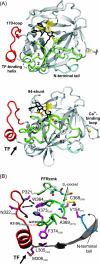A combined structural dynamics approach identifies a putative switch in factor VIIa employed by tissue factor to initiate blood coagulation
- PMID: 17384232
- PMCID: PMC2203332
- DOI: 10.1110/ps.062504907
A combined structural dynamics approach identifies a putative switch in factor VIIa employed by tissue factor to initiate blood coagulation
Abstract
Coagulation factor VIIa (FVIIa) requires tissue factor (TF) to attain full catalytic competency and to initiate blood coagulation. In this study, the mechanism by which TF allosterically activates FVIIa is investigated by a structural dynamics approach that combines molecular dynamics (MD) simulations and hydrogen/deuterium exchange (HX) mass spectrometry on free and TF-bound FVIIa. The differences in conformational dynamics from MD simulations are shown to be confined to regions of FVIIa observed to undergo structural stabilization as judged by HX experiments, especially implicating activation loop 3 (residues 365-374{216-225}) of the so-called activation domain and the 170-loop (residues 313-322{170A-175}) succeeding the TF-binding helix. The latter finding is corroborated by experiments demonstrating rapid deglycosylation of Asn322 in free FVIIa by PNGase F but almost complete protection in the presence of TF or an active-site inhibitor. Based on MD simulations, a key switch of the TF-induced structural changes is identified as the interacting pair Leu305{163} and Phe374{225} in FVIIa, whose mutual conformations are guided by the presence of TF and observed to be closely linked to the structural stability of activation loop 3. Altogether, our findings strongly support an allosteric activation mechanism initiated by the stabilization of the Leu305{163}/Phe374{225} pair, which, in turn, stabilizes activation loop 3 and the S(1) and S(3) substrate pockets, the activation pocket, and N-terminal insertion.
Figures





Similar articles
-
Structural modulation of factor VIIa by full-length tissue factor (TF1-263): implication of novel interactions between EGF2 domain and TF.J Biomol Struct Dyn. 2018 Feb;36(3):621-633. doi: 10.1080/07391102.2017.1289125. Epub 2017 Feb 17. J Biomol Struct Dyn. 2018. PMID: 28150568
-
Evolutionary conservation of the allosteric activation of factor VIIa by tissue factor in lamprey.J Thromb Haemost. 2018 Apr;16(4):734-748. doi: 10.1111/jth.13968. Epub 2018 Mar 12. J Thromb Haemost. 2018. PMID: 29418058 Free PMC article.
-
The origins of enhanced activity in factor VIIa analogs and the interplay between key allosteric sites revealed by hydrogen exchange mass spectrometry.J Biol Chem. 2008 May 9;283(19):13378-87. doi: 10.1074/jbc.M709716200. Epub 2008 Mar 14. J Biol Chem. 2008. PMID: 18343822
-
Allosteric activation of coagulation factor VIIa.Front Biosci (Landmark Ed). 2011 Jun 1;16(8):3156-63. doi: 10.2741/3903. Front Biosci (Landmark Ed). 2011. PMID: 21622226 Review.
-
Structural biology of factor VIIa/tissue factor initiated coagulation.Front Biosci (Landmark Ed). 2012 Jun 1;17(7):2476-94. doi: 10.2741/4066. Front Biosci (Landmark Ed). 2012. PMID: 22652793 Free PMC article. Review.
Cited by
-
Factor VII levels, R353Q and -323P0/10 Factor VII variants, and the risk of acute coronary syndrome among Arab-African Tunisians.Mol Biol Rep. 2013 May;40(5):3793-8. doi: 10.1007/s11033-012-2456-4. Epub 2012 Dec 30. Mol Biol Rep. 2013. PMID: 23275237
-
A systematic approach for evaluating the role of surface-exposed loops in trypsin-like serine proteases applied to the 170 loop in coagulation factor VIIa.Sci Rep. 2022 Mar 8;12(1):3747. doi: 10.1038/s41598-022-07620-7. Sci Rep. 2022. PMID: 35260627 Free PMC article.
-
Uncovering Membrane-Bound Models of Coagulation Factors by Combined Experimental and Computational Approaches.Thromb Haemost. 2021 Sep;121(9):1122-1137. doi: 10.1055/s-0040-1722187. Epub 2021 Jul 2. Thromb Haemost. 2021. PMID: 34214998 Free PMC article. Review.
-
The utility of hydrogen/deuterium exchange mass spectrometry in biopharmaceutical comparability studies.J Pharm Sci. 2011 Jun;100(6):2071-86. doi: 10.1002/jps.22432. Epub 2010 Dec 29. J Pharm Sci. 2011. PMID: 21491437 Free PMC article.
-
Folding and assembly of large macromolecular complexes monitored by hydrogen-deuterium exchange and mass spectrometry.Microb Cell Fact. 2008 Apr 4;7:12. doi: 10.1186/1475-2859-7-12. Microb Cell Fact. 2008. PMID: 18394161 Free PMC article.
References
-
- Bajaj S.P., Schmidt, A.E., Agah, S., Bajaj, M.S., and Padmanabhan, K. 2006. High resolution structures of p-aminobenzamidine- and benzamidine-VIIa/soluble tissue factor: Unpredicted conformation of the 192–193 peptide bond and mapping of Ca2+, Mg2+, Na+ and Zn2+ sites in factor VIIa. J. Biol. Chem. 281: 24873–24888. - PubMed
-
- Banner D.W., D'Arcy, A., Chène, C., Winkler, F.K., Guha, A., Konigsberg, W.H., Nemerson, Y., and Kirchhofer, D. 1996. The crystal structure of the complex of blood coagulation factor VIIa with soluble tissue factor. Nature 380: 41–46. - PubMed
-
- Davie E.W., Fujikawa, K., and Kisiel, W. 1991. The coagulation cascade: Initiation, maintenance, and regulation. Biochemistry 30: 10363–10370. - PubMed
MeSH terms
Substances
LinkOut - more resources
Full Text Sources
Miscellaneous

